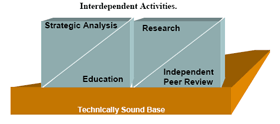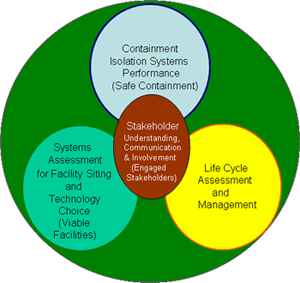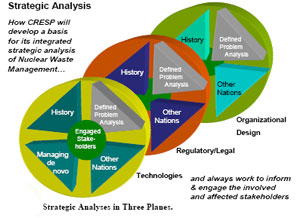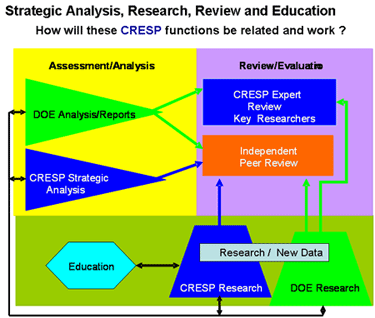![]()
About CRESP
The Consortium for Risk Evaluation with Stakeholder Participation CRESP III is a five year (2006 - 2011) Department of Energy cooperative agreement awarded to Vanderbilt University. The multi-university consortium is working to advance cost-effective, risk-informed cleanup of the nation's nuclear weapons production facility sites and cost effective, risk-informed management of potential future nuclear sites and wastes.
CRESP III Mission
The mission of CRESP III is to advance cost-effective, risk-informed cleanup of the nation's nuclear weapons production facility sites and cost effective, risk-informed management of potential future nuclear sites and wastes. This will be accomplished by seeking to improve the scientific and technical basis for environmental management decisions by the Department of Energy and by fostering public participation in that search.
Scope
The CRESP III project will help define and assess the technical and regulatory scope and approaches useful for the Department as it strives to undertake its cleanup and stewardship responsibilities in a protective and cost-effective manner at contaminated sites, and plan and manage potential future nuclear sites and wastes. The project effort will focus on supporting independent and collaborative research, reviews, methods, data gathering and stakeholder participation needed for effective evaluation and communication of DOE related health, environmental and other risks. The project will focus responsively on important cleanup-related challenges at the sites and on the end states which cleanups seek to achieve, and planning and management challenges for potential future nuclear sites and wastes. The project effort will accomplish the outcomes by:
- performing targeted studies on specific risk related issues important to the longterm management of environmental problems;
- contributing to risk evaluation and assessment, or to the development of related methodologies, relevant to' risk issues at a number of DOE sites;
- focusing on the collection and analysis of data needed for effective risk evaluation, and on the definition and assessment of relevant technical and regulatory approaches valuable in resolving risk-related issues;
- providing an independent mechanism to support the assessment of DOE'S needs for research, to critique current research, and to develop data relevant to the concerns of the public, to support planning and to be responsive to evolving regulatory commitments; and
- supporting efforts to improve working relationships and communications with the public and stakeholders at sites and across the DOE complex.
The CRESP Approach
The CRESP approach to help DOE integrate nuclear waste management problems is to carry out independent strategic analysis, review, research and education, while continuously engaging the full range of stakeholders.

CRESP III Focus Areas
CRESP III proposes to address the current absence of nuclear waste management integration through a distinctive set of four interdependent activities, (a) strategic analysis, (b) review, (c) applied research, and (d) education, all organized around a set of four interrelated focus areas.

Focus Area 1: Evaluation of Waste Forms and Contaminant Isolation Systems
Performance. CRESP III will perform coordinated research, strategic assessment and reviews
focused on developing tools and techniques to assess and enhance the integrated
performance of engineered and institutional features of waste containment, land disposal
systems and isolation of residual contamination during and after remediation and near
surface waste disposal.
Focus Area 2: Life-cycle Risk, Cost and Benefit Assessment for Selecting from
Management Options. CRESP III will develop and demonstrate appropriate use of methodologies for
advancing, and communicating methods for comparative life-cycle risk, benefit (human
health and ecological resources) and cost assessment as tools for risk-informed selection
amongst different environmental restoration and nuclear waste management options.
Focus Area 3: Systems Assessment for Siting Processes and Technology
Choices for Future Nuclear Waste Management Facilities.CRESP III will evaluate siting processes and technology choices for nuclear waste
management facilities by examining the potential benefits/limitations of integrated
approaches to resolving nuclear waste challenges by defining/evaluating considerations
for site locations (e.g., impacts of populations, natural resources, transportation) and the
appropriate existing or evolving technologies needed for each type of nuclear waste
management facility (e.g., interim storage, reprocessing); in doing so it will assess the
evolving technical approaches to future fuel cycles, emphasizing the external technical
(e.g., ultimate waste and secondary waste requirements), economic, social and policy
considerations associated with implementation of such facilities.
Focus Area 4: Stakeholder Understanding, Communication and Involvement. CRESP III will assess, recommend and demonstrate approaches to more credibly
incorporate involvement of the diverse stakeholders who can shape decisions to achieve
technically-sound nuclear waste management. The activities for this task shall include, but
not necessarily be limited to carrying out focus groups, surveys, development of
communication tools and educational materials, and carrying out case and organizational
studies to determine whether, and if so how, improved DOE organization, public
involvement practices and procedures, and training would foster confidence in such
approaches. This would include an analysis of relevant successful examples of
stakeholder involvement in nuclear waste management policy or similarly complex
decisions in the United States and other countries.
![]()
CRESP III Strategic Analysis, Review and Education Activities
CRESP III Strategic Analysis
The CRESP III Strategic Analysis activity provides multi-disciplinary assessment of strategic nuclear waste management issues and initiatives carried out by CRESP senior researchers, typically working together and in concert with established national and international leaders to identify information gaps and evaluate alternative pathways to progress.

CRESP III Review Activities
The CRESP III review activities provide several types of independent multi-disciplinary peer-review of key CRESP, DOE and other projects and reports related to nuclear waste that are to serve as prototypes or the foundation for major nuclear waste decisions such as specific restoration options, performance assessments, environmental impact statements, etc.
CRESP will provide three different types of review capabilities or functions:
A. Informal Review
The Informal review function is conducted by CRESP researchers (possibly augmented by additional experts and informed stakeholders to fill in gaps) in the early stages of a research or waste management project to help define or determine the status of the technical situation, science or problem.
B. Senior Multi-disciplinary Review Teams
CRESP reviews during project formulation and at key milestones or reports is central to effective management of highly complex projects. CRESP senior research teams will carry out multi-disciplinary reviews by assembling necessary experts independently or provide personnel to augment DOE/regulatory personnel for project evaluation at critical stages (e.g., reviewing DOE CD 0 and CD 1 project definitions) and site reviews (e.g., baseline reviews, performance assessments).
C. Peer Review Committee
The primary purpose of the CRESP Independent Peer Review Board is to ensure the scientific soundness of studies, procedures, and/or reports that are of major importance to CRESP or its stakeholders, in order that their reliability and credibility can be maximized.
Scope and Issues Addressed:
The Board is responsible for reviewing selected studies,
work plans, or issues that are judged by CRESP scientists or others to be pivotal to the
resolution of key questions. Such items may include, but are not limited to, research
plans, study protocols, investigative procedures, project reports, risk assessments, risk
management strategies, and programmatic research needs, accomplishments, and/or
opportunities. Individual CRESP research products are generally published in the peer reviewed literature and are not, therefore, routinely reviewed by the Committee. But
there are frequent exceptions. CRESP work is often completed first in reports that are
developed to respond to concerns that are controversial and/or are great significance to
the Department and or its stakeholders – and can be expected to shape decisions before
the work is reviewed and published in the peer reviewed literature. This has occurred one
or several times per year – as with the CRESP epidemiology work at SRS, the Amchitka
Independent Science Plan and then the report of the Amchitka results, its Addendum and
the Amchitka biomonitoring report, the CRESP review of the SRS Integrated Priority
List (all discussed earlier in this proposal). In these cases, the review committee chairman
creates a review panel of appropriate experts and their review typically precedes distribution of the CRESP report or publication of it on the CRESP website and the
authors of the CRESP Report typically revise their report to address the peer review
criticisms and comments.
Items for review by the Independent Peer Review Board may be referred to it by the CRESP Management Board based on either the Management Board’s initiative or based on requests from CRESP investigators, the Department of Energy, or other concerned individuals or organizations. The funds to support the Independent Peer Review Board’s efforts are derived entirely from CRESP’s operating budget.
Issues to be considered by the Board in evaluating a given body of work, study plan, or process include: 1) the appropriateness of its methodology; 2) the effectiveness with which the methods are applied; 3) the completeness with which any observed results are documented; 4) the extent to which the results support conclusions that are presented; 5) the clarity and completeness with which the work or process is described; 6) the adequacy of measures for quality assurance; 7) the extent to which the work advances existing knowledge; 8) any health, environmental, and/or policy implications the item may have; 9) any research needs or research opportunities it may identify; and 10) its significance to DOE’s mission and to stakeholders.
Form and Distribution of Peer Review Reports:
Each report produced by the Board is
written in language intended to be intelligible to a broad readership, so as to be credible
and meaningful to stakeholders of varying backgrounds, as well as to scientists and
decision-makers. Copies of reports are distributed by the Chair to the CRESP
Management Board, the Department of Energy, those whose work has been evaluated, and to others who may be interested. The reports are also listed and accessible through the internet via the CRESP web site.
CRESP III Education Activities
The educational function of CRESP will (i) provide a multi-disciplinary foundation for the next generation of professionals in nuclear waste management through graduate and post-graduate training, (ii) develop materials and carry out workshops to facilitate improved dialogue with stakeholders and communications with the media, and (iii) introduce nuclear waste management and professional challenges and opportunities to undergraduates through summer internships. Specific components of CRESP education activities are to:
• Educate and train graduate and post-graduate students in the multi-disciplinary skills necessary to prepare the next generation of professionals to meet the challenges of nuclear waste management, including health physics, environmental systems (science and engineering), risk analysis, risk communication, and law and public policy.
• Develop educational materials, workshops and communication tools for targeted stakeholder audiences.
• Support international exchange of technical and policy researchers for the United States to benefit from the experience of other countries in nuclear waste management. This exchange is envisioned to be carried out in conjunction with specific research projects and workshops.

The multi-university Consortium for Risk Evaluation with Stakeholder Participation is funded by the Department of Energy through a cooperative agreement for the next five years (2006 - 2011 ) to continue to work with DOE and its stakeholders on how to clean up legacy wastes from the nuclear arms race and to contribute to the technical foundation for safe management of nuclear waste from a wide range of sources.
CRESP has since 1995 been researching ways to advance cost-effective clean up of the nation’s nuclear weapons production waste sites and test facilities. The Consortium responded to the request by the Department of Energy and the National Research Council for the creation of an independent institutional mechanism to develop data and methodology to make risk a key part of its decision making at the Environmental Management Office of DOE. As a result of a national competition, a five-year cooperative agreement was awarded to CRESP in March of 1995. CRESP Co-founders and initial management board included Drs. Bernard D. Goldstein, John A. Moore, Gilbert S. Omenn, Charles W. Powers and Arthur C. Upton in 1995. CRESP I was institutionally managed by the Environmental Occupational Health Sciences Institute in New Jersey with Bernard D. Goldstein as Principal Investigator, and Charles W. Powers as Executive Director.
The first five year cooperative agreement was renewed in 2000 with the Institute for Responsible Management as lead institution and Charles W. Powers as Principal Investigator. The CRESP II management board included Charles W. Powers, Bernard D. Goldstein and CRESP lead research scientists Joanna Burger (Rutgers University), Michael Greenberg (Rutgers University), and David Kosson (Vanderbilt University). CRESP worked to improve the scientific and technical basis of environmental management decisions leading to advance protective and cost-effective cleanup of the nation's nuclear weapons; and enhance stakeholder understanding of the nation's nuclear weapons production facility waste sites. CRESP II pursued this work through a unique institutional model: (1) Its primary mode of operation is an unprecedented program of interdisciplinary university research; (2) It is independent and its beneficiaries are those who have a stake in effective cleanup of federal facilities; (3) It is organized to provide both guidance to and peer review of the evolving effort to utilize risk methods and evaluations to shape cleanup decisions at DOE sites.
CRESP III was renewed as a Department of Energy cooperative agreement in the fall of 2006 with Vanderbilt University as the lead organization, and Charles W. Powers and David S. Kosson as co-principal investigators. The management board membership was broadened to include a diverse set of skills and interests to the issues at hand. The CRESP III board members include David S. Kosson and Charles W. Powers (Vanderbilt University), Joanna Burger and Michael R. Greenberg (Rutgers University), Kathryn A. Higley (Oregon State University), James H. Johnson (Howard University), and Richard B. Stewart (New York University School of Law). The objective of the CRESP III project is to advance cost-effective, risk-informed cleanup of the nation's nuclear weapons production facility waste sites and cost-effective, risk-informed management of potential future nuclear sites and wastes. This will be accomplished by seeking to improve the scientific and technical basis for environmental management decisions by the Department of Energy, and by fostering public participation in that search.
The CRESP areas of expertise include: Engineering (chemical, civil, environmental and nuclear), ecology, economics, ethics, geology, health physics, law, occupational medicine, organizational behavior, project and fiscal management, public health, public policy, subsurface remediation, risk evaluation, and risk communication.

CRESP III Management Board Team: David Kosson and Charles Powers, CRESP III Co-Principal Investigators, Kathryn Higley, James Johnson, Joanna Burger, Michael Greenberg, and Richard Stewart (l-r), Shlomo P. Neuman, absent.
